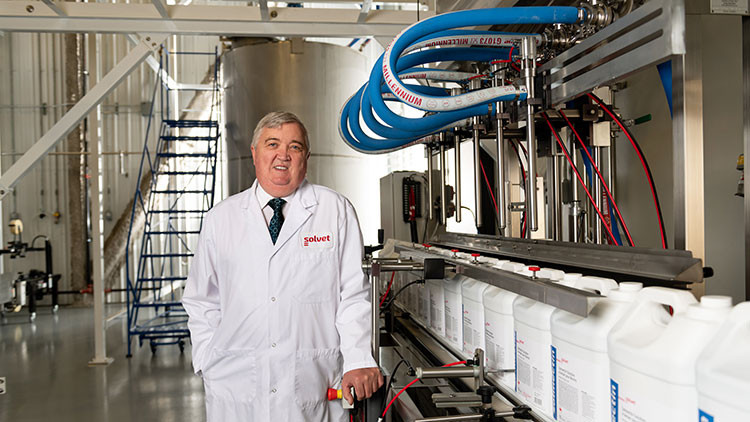Government mail service may be affected by the Canada Post labour disruption. Learn about how critical government mail will be handled.

"My mentors have all empowered my confidence in my abilities. I had great supervisors in university and great veterinarians as colleagues. They were knowledgeable, kind and understanding. They taught me not only how to do science, but also how to be a kind person. It was a collaboration, not a competition."
Dr. Merle Olson is an internationally recognized veterinarian, researcher, entrepreneur and teacher. Together with Barb, his wife of 40 years, Merle co-founded several biotech and pharmaceutical companies specializing in veterinary products to control pain and protect the health and well-being of animals. His work improves animal welfare, saves producers millions of dollars annually and has led to a better understanding of bacterial infections in humans, animals and crops.
Merle Edwin Olson was born in Radville, Saskatchewan, about 70 miles south of Regina on November 13, 1953, as the younger of two boys. His parents ran a mixed 640-acre farm, between Radville and Ceylon, where they grew wheat and raised cattle, chickens and pigs. By the age of 12, Merle was responsible for looking after livestock, and through the daily chores of collecting eggs, milking cows and feeding pigs, he developed a passion for the practice of animal husbandry, as well as a tremendous respect for the animals on which his family depended.
Merle attended school in the village of Ceylon, switching to homeschooling in winter when roads were often snowed in. To earn extra money, he trapped beavers, mink and muskrats, selling pelts to the Hudson’s Bay Company. Despite his issues with what is now understood to be Attention Deficit Disorder, Merle always had an academic bent and was especially strong in math and the sciences. Supported by his parents, who were firm believers in the value of education, he graduated in 1971 as valedictorian of his class of 10 students.
After high school, having wavered between farming and academia, Merle ultimately resolved to expand his knowledge and enrolled at the University of Saskatchewan, Regina Campus (now the University of Regina). Despite the culture shock of the shift from rural to urban life, Merle’s passion for science and math helped him thrive in his classes. In 1975, he graduated with a B.Sc. (high honours) with majors in chemistry and biology, having completed five years of course work in only four years.
With support from a Natural Sciences and Engineering (NSERC) scholarship, Merle migrated across Canada to study for his master’s degree at the University of Western Ontario (now Western University) in London, Ontario. Confronted with another round of culture shock, he managed to adjust to life at a prestigious eastern university and excelled in his classes, publishing several of his first research papers. In 1977, he graduated with an M.Sc. in electrochemistry. However, recognizing that his true calling was to work with animals, he entered the University of Saskatchewan’s Western College of Veterinary Medicine that fall.
Although immersed in studying for his doctorate of veterinary medicine (DVM), Merle found enough time to sign up for ballroom dance classes. One night outside class, he stopped to help fix a flat tire and met Barb, a grad student in veterinary physiology who would become his wife and partner in research and business. It was a match made in heaven. As Merle notes, “We both love doing research, being outdoors, being around animals. Our backgrounds complement each other.”
After graduating in 1981, Merle joined a two-person large-animal practice in Pincher Creek, Alberta, near his parents. Life proved hectic in a farming and ranching community home to large populations of beef cattle and horses. Merle was on call every second night and every second weekend, in addition to working all day and most nights during calving season.
Although he loved his job, the research drew him back to academia in 1984, when he accepted a faculty position in Biological Sciences and later Medicine at the University of Calgary. Merle would spend two productive decades in Alberta’s post-secondary education system, running applied research programs with his wife in microbiology, parasitology and pharmacology. As part of the internationally recognized Biofilm Research Group, the Olsons conducted trailblazing investigations into how bacterial biofilms impact chronic infectious diseases, such as urinary tract infections and pneumonia, by protecting them from antibiotics and the immune system. Their work led to the development of the first diagnostic kit to help doctors choose the best antimicrobials to treat infections associated with cystic fibrosis. This assay, called the “Calgary Biofilm Device,” is now used worldwide in human medicine, veterinary medicine and even plant pathology, where it has been used to fight bacterial ring rot in potatoes.
During his time at the University of Calgary, Merle partnered with government agencies to solve pressing problems for the agri-food sector. For example, he took the lead in creating Alfasure, a treatment that allows cattle to graze on high-protein alfalfa without risking life-threatening bloat. One product had been developed in New Zealand but was barred from Canada due to a banned ingredient. Merle reverse-engineered the product and created a new bloat control agent that met domestic standards and is now manufactured in Canada.
In 2004, Merle and Barb made a team decision to take early retirement from the university and jump to the private sector. All of Merle’s experiences as a rural vet and urban professor would combine to guide the next phase of his life.
As a vet, he’d noticed the unmet needs that livestock producers grappled with daily, one of the most obvious being pain control in livestock. As a professor, he’d grown frustrated that many local biotech products never made it out of the lab, or were often moved to other jurisdictions before coming to market. At that time, virtually all major pharmaceutical products tied to the livestock industry were made outside of Canada. This posed a significant problem for Alberta producers as they had to pay more for products designed without consideration for Alberta’s climate and geography. The Olsons believed that veterinary pharmaceuticals should be developed, proven and manufactured in Alberta.
Merle and Barb resolved to launch made-in-Alberta biotech ventures to serve the livestock industry, based on the model of talking to farmers and vets to identify problems and then offering solutions to those problems. So they founded a publicly traded biotech company, Innovotech, which is now based in Edmonton and provides products and services based on the Olsons’ biofilm research.
Alberta Veterinary Laboratories (AVL) and Solvet Animal Health are devoted to researching and manufacturing made-in-Alberta livestock pharmaceuticals. The Olsons built a state-of-the-art manufacturing plant in Calgary to make veterinary pharmaceuticals. AVL has won widespread praise from farmers and ranchers for developing an economical parasite control product for cattle. Comparable products were much more expensive, forcing producers to reduce their profitability or compromise the health of their herds. AVL’s Ivermectin Pour-On for Cattle brought competition into the marketplace and, since 2009, has saved the industry an estimated $9 million annually while improving animal health and welfare.
Driven by Merle and Barb’s relentless dedication to innovation, AVL has registered and begun sales of at least one new veterinary product in each year of its operations. AVL’s pain-control drugs are now used on livestock across Canada for many painful procedures and diseases. AVL has developed large pills (boluses) to treat and prevent metabolic diseases in cattle and novel products designed to reduce the agricultural use of antibiotics in livestock. AVL now has over 50 employees, including chemists, biochemists, pharmacists, veterinarians, engineers and accountants.
Merle and Barb have worked with Alberta physicians and scientists to develop human products, such as RhinoRinse (a novel nasal flush solution) and Acticoat™ (a silver antimicrobial bandage).
Merle has received numerous awards for a lifetime of achievements, including the Veterinarian of the Year Award from the Alberta Veterinary Medical Association in 1997. In addition, he was awarded the Charles River Award in Laboratory Animal Care in 1992 and in 2016 he received the Award of Distinction for Innovation from Alberta Farm Animal Care.
Merle and Barb live in Calgary during the week and enjoy weekends in Canmore in a home built with logs they harvested, cut and shaped themselves. They have three grown sons and enjoy hiking, skiing, cycling and canoeing in Canmore’s backcountry. They remain as active as ever in business and research, currently working on a delivery mechanism to extend pain-control product delivery in band-castrated animals. Together, they hold more than 50 patents in medicine, parasitology and pharmacology. In addition, they have produced over 250 peer-reviewed publications and 13 book chapters. They learned of their selection for the Alberta Order of Excellence on their 40th wedding anniversary.
